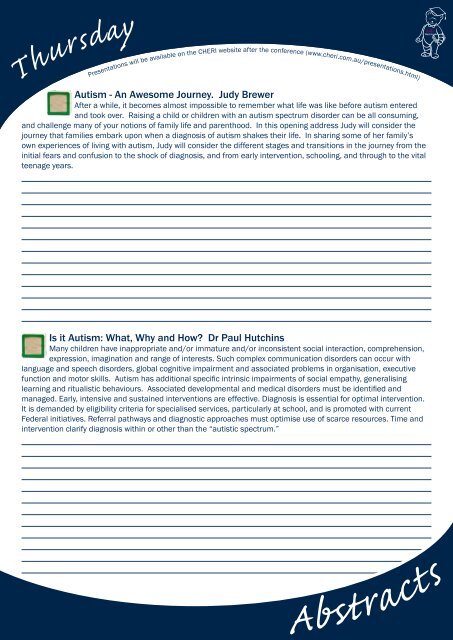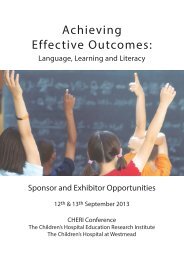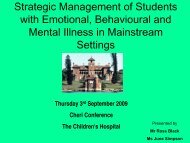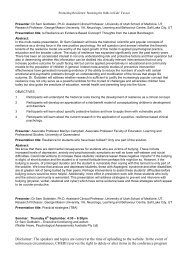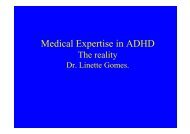autis - CHERI - The Children's Hospital Education Research Institute
autis - CHERI - The Children's Hospital Education Research Institute
autis - CHERI - The Children's Hospital Education Research Institute
Create successful ePaper yourself
Turn your PDF publications into a flip-book with our unique Google optimized e-Paper software.
Thursday<br />
Presentations will be available on the <strong>CHERI</strong> website after the conference (www.cheri.com.au/presentations.html)<br />
Autism - An Awesome Journey. Judy Brewer<br />
After a while, it becomes almost impossible to remember what life was like before <strong>autis</strong>m entered<br />
and took over. Raising a child or children with an <strong>autis</strong>m spectrum disorder can be all consuming,<br />
and challenge many of your notions of family life and parenthood. In this opening address Judy will consider the<br />
journey that families embark upon when a diagnosis of <strong>autis</strong>m shakes their life. In sharing some of her family’s<br />
own experiences of living with <strong>autis</strong>m, Judy will consider the different stages and transitions in the journey from the<br />
initial fears and confusion to the shock of diagnosis, and from early intervention, schooling, and through to the vital<br />
teenage years.<br />
Is it Autism: What, Why and How Dr Paul Hutchins<br />
Many children have inappropriate and/or immature and/or inconsistent social interaction, comprehension,<br />
expression, imagination and range of interests. Such complex communication disorders can occur with<br />
language and speech disorders, global cognitive impairment and associated problems in organisation, executive<br />
function and motor skills. Autism has additional specific intrinsic impairments of social empathy, generalising<br />
learning and ritualistic behaviours. Associated developmental and medical disorders must be identified and<br />
managed. Early, intensive and sustained interventions are effective. Diagnosis is essential for optimal intervention.<br />
It is demanded by eligibility criteria for specialised services, particularly at school, and is promoted with current<br />
Federal initiatives. Referral pathways and diagnostic approaches must optimise use of scarce resources. Time and<br />
intervention clarify diagnosis within or other than the “<strong>autis</strong>tic spectrum.”<br />
Abstracts


